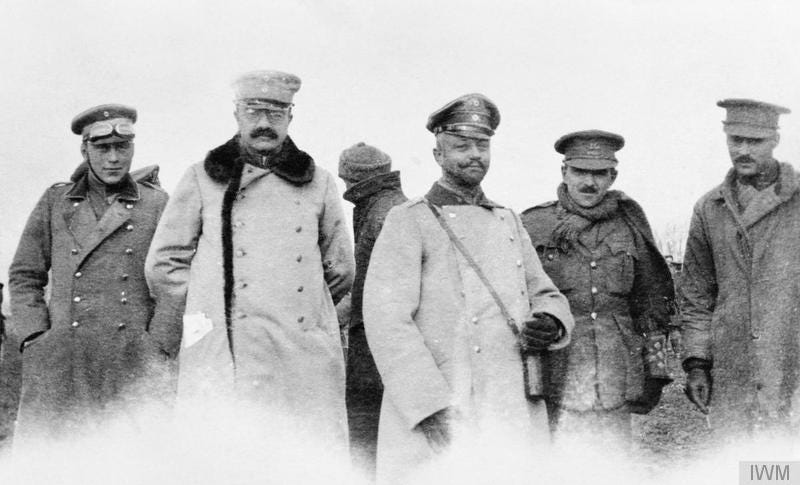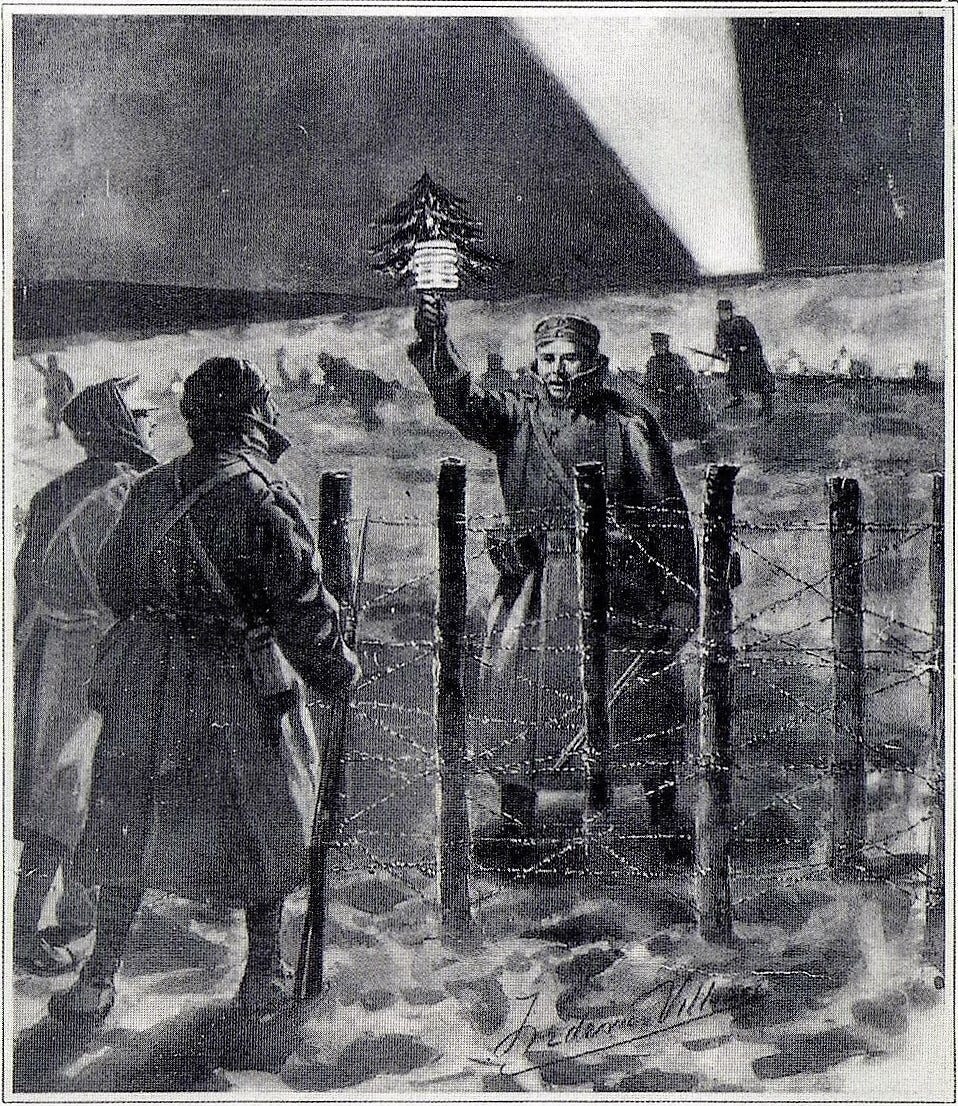It’s a Christmas tale that’s been told many times. Many of us have heard the outline, if not the details.
On December 24, 1914, German troops in the area of Ypres, Belgium went seriously off-message by mounting Christmas trees on the parapets of their trenches. Decorated with candles, no less.
Throughout the day they sang Christmas carols to their enemies across the muddy no-man's land. The British troops responded by singing carols in English. By nightfall soldiers on both sides had left the trenches to mingle and exchange gifts of whisky, jam, cigars, chocolate and the like. According to military historian Gwynne Dyer, the Christmas truce spread down both the European trenches “at the speed of candlelight." French soldiers also joined in the boundary-shattering sharing with the British.

There are variations in this often-told tale, but most historians agree the Germans initiated the truce, which led to Christmas day soccer games with the British.
The horrified high command of nations sent out immediate orders against fraternization. It took days before all the men had returned to the trenches, back to the vital business of killing each other off like flies.

It’s safe to say the vast majority of human beings have always preferred Christmas-like camaraderie over mud-caked combat. At our worst, we’re natural born kibbitzers much more than natural born killers.
And it takes some effort to undo that.
In World War 1, US wartime psychologists discovered that combat trainees were greatly reluctant to fire directly on other human beings, even in combat situations. As Gwynne Dyer relates in his book War: The Lethal Custom, boot camp was conceived largely to reverse the process of normal childhood socialization. (Without this vital readying for combat, commanders discovered a large fraction of soldiers had a bad habit of raising their guns at the last instant when firing, avoiding a direct shot.)
We’re social animals by nature, and even in peacetime there is enormous plasticity in our behaviour, crossing the spectrum from psychopath to Good Samaritan. Or in the parlance of game theory, from “winner take all” to “win-win.”
Yet when faced with natural or man-made disasters, it seems we’re more likely to behave not in mutually destructive behaviour, but in socially creative, even joyous, engagement.
A Paradise Built in Hell
That’s counterintuitive thesis in Rebecca Solnit’s 2010 book, A Paradise Built in Hell: The Extraordinary Communities That Arise in Disaster. The author examines a number of historical disasters, including the 1906 earthquake in San Francisco, the 1917 harbour explosion in Halifax, the 1985 Mexico City earthquake, 9/11 in Manhattan, and 2004’s Hurricane Katrina in New Orleans.
She relates how American philosopher William James reported widespread cooperation and goodwill in the aftermath of the 1906 earthquake in San Francisco. It was his brother on the opposite coast, Henry James the novelist, who imagined the worst by mail - “mangled forms, hollow eyes, starving bodies, minds insane with fear.”
Nearly a century later, writer Stephan Doheny-Farina remarked on the counterintuitive responses to the 1998 ice storm that paralyzed much of Quebec. “...As as the power grid fails, in its place arose of vibrant grid of social ties – formal and informal, organized and serendipitous, public and private, official and ad hoc.”
A similar dynamic applied to the 2016 wildfire in Fort McMurray, Alberta. Many pundits expressed surprise at the cooperative behaviour of residents faced with an immediate, massive threat. “When disaster hit, the people of Fort McMurray showed their better natures, not the instincts of ‘survivalists,’ Macleans offered.
This flow of social capital into destroyed spaces isn’t unusual, Solnit argues. Ironically, it’s the shutdown mindset of officialdom (predicated on the notion of impending social chaos) that often makes things worse. She relates how the real chaos following the 1906 San Francisco earthquake began when authorities sent the police in to restore order, by breaking up the neighborhood organizations that arose spontaneously.
Solnit resurrects an obscure sociologist, Charles E. Fritz, to explain the emergent property of disaster-mediated reconnection.
Disasters provide a temporary liberation from the worries, inhibitions and anxieties associated with the past and future because they force people to concentrate their full attention on immediate moment-to-moment, day-to-day needs within the context of present realities…Disaster provides a form of societal shock which disrupts habitual, institutionalized patterns of behaviour and renders people amenable to social and personal change.
This hardly make disasters a good thing. But if institutional mechanisms of social cohesion vapourize in catastrophic circumstances, the grassroots response is more likely to lean toward freely chosen cooperation than toward a Hobbesian “war of all against all.”
In fact, the feelings of liberation reported by people in disaster situations highlights an unfortunate truth: modern market economies are engineered to shape people into isolated consumers rather than engaged citizens. When the atomizing lid is removed, many people become tremendously excited by their own sense of agency and capacity to bond with their fellows. Of course, that’s next to impossible when a state-orchestrated state of emergency isolates people for their supposed own good (contemporary architects of social distancing, take note).
In closing, I’d like share another author’s powerful anecdote about human connection.
In his 2001 book, After the Ecstasy, the Laundry, psychologist Jack Kornfield describes a conversation he had on a train with an African-American man who ran a rehabilitation program for juvenile offenders in the District of Columbia. The man tells the author of a 14-year-old boy in the program, who shot and killed an innocent teenager to prove himself to his gang.
At the trial, the victim’s mother sat and said nothing, until the very end, when the youth was convicted of the killing. After the verdict was announced, she stood up slowly and staring directly at him, said, “I’m going to kill you.” The youth was then led off to serve several years in the juvenile facility.
Kornfield describes how after the first six months the mother of the slain teenager went to visit the killer. He had been homeless before the killing, and she was his only visitor. They talked, and she gave him money to buy cigarettes before she left (sounds like an excellent way to stealthily kill someone). She started to visit him then on a regular basis, each time bringing food and small items.
Near the end of his three-year sentence, she asked him what he would be doing when he got out. He was confused and very uncertain, so she offered to help set him up with a job at a friend’s company. Then she inquired about where he would live, and since he had no family to return to, she offered him temporary use of the spare room in her home. For eight months he lived there, ate her food, and worked at the job. Then one evening she called him into the living room to talk. She sat down opposite him and waited. Then she started, “Do you remember in the courtroom when I said I was going to kill you?” “I sure do,” he replied. “I'll never forget that moment.”
“Well, I did,” she went on. “I did not want the boy who could kill my son for no reason to remain alive on this earth. I wanted him to die. That’s why I started to visit you and bring you things. That’s why I got you the job and let you live here in my house. That’s how I set about changing you. And that old boy, he’s gone. So now I want to ask you, since my son is gone, and that killer is gone, if you’ll stay here. I’ve got room, and I’d like to adopt you if you let me.” And she became the mother he never had.
There’s no explicit Christmas elements in Kornfield’s unsourced anecdote. Yet this tale of a nameless mother’s choice of bonding over bitterness, of reconciliation over revenge, of love over fear, hits all the archetypal high points of the holiday spirit. This woman made a conscious choice - one probably impossible for most anyone else in a similar situation - to cast a light into the darkness, battling for a larger connection with an implacable enemy.
Not unlike the Germans of the World War 1 trenches, the “evil Hun” whose candlelit Christmas trees commenced a short-lived Peace on Earth.






Heart warming and true. The future holds the potential for climate catastrophes, where people will rally around each other and do their best to survive. I sense that this will eventually upset the apple cart of cancer-stage capitalism and we will return to something more humane and decentralized.
By this time next year or the year after, the world is going to be a completely different place. It will be tough and ongoing but will require intense cooperation, good will and love just to survive.
Right on! Right on! Write on! I find it terribly sad that the notion of Christmas as the time when was born The Prince of Peace has been largely removed from the celebrations, festivities, ceremonies, and traditions. Peace isn't profitable. Christmas is the best time for business and war is the biggest business in the world. Ergo Christmas is the best time for war - war against insufficient material goodies. That's a war retailers will always win and folks will always lose. Could be worse - could say Santa is a warmonger. (lol). But capitalism has sucked the morality and ethics out of everything because morality and ethics, with the exception of the god-like work ethic, are bad for business. Modern religions have sucked the Judao-Christian ethics out of our lives. Blah blah blah... Humanity has taken a number of wrong turns on the Information Superhighway and gotten lost in a bad part of the universe. Somebody call humanity a taxi. l(lol0.